Looking for a Partner to Build an AI Lease Abstraction Tool?
Leverage our expertise in real estate, legal, and financial industries to automate the lease management process.
On average, lease abstracting takes 4-8 hours for a broker to complete, which is no wonder, since most leases include complex cases and legal terminology that demand meticulous attention to detail.
ChatGPT may be of help here, but due to security concerns and its inability to scan PDF documents and handwriting, you might want to benefit from a more secure and advanced AI lease abstraction tool.
As we have been actively working around developing a lease abstraction AI tool ourselves, we are happy to guide you through the AI lease abstraction process, the limitations of the AI lease abstraction tools that are out there on the market and how to surpass them.
AI lease abstraction is the process of extracting key information like parties’ responsibilities, lease terms, and financial obligations with the help of AI-powered lease abstraction tools from a commercial lease agreement and summarizing it into a concise document.
In fact, automated lease abstraction can save up to 25% of broker’s time, according to CBRE.
Lease abstract is a concise summary of a commercial lease agreement, hence called ‘commercial lease abstract’ in real estate, that contains key details such as lease terms, obligations of the parties involved, and financial aspects, all provided in a structured manner.
Leverage our expertise in real estate, legal, and financial industries to automate the lease management process.
The result of the automated lease abstraction should be presented in a concise but a well-structured manner, often as a list that includes the essential details such as:
Tenant Information – tenant’s full name and current address, their rent history, financial records, and the outcomes of background checks (if any were conducted);
Second Party – this section identifies the second party involved in the commercial lease agreement, typically the landlord or property owner. Their legal identity, contact information, and any pertinent details relevant to the lease should be clearly outlined;
Base and Total Prices – the basic rent as well as any additional costs associated with the property;
Parties’ Rights and Responsibilities – tenant termination rights, permissions related to property remodeling, and the tenant’s right of first refusal. As for the landlord’s rights and responsibilities – rent collection, property inspection, maintenance and repairs, eviction rights, and lease renewal;
Taxes – the lease abstract should specify which taxes are the responsibility of the tenant and which are the responsibility of the landlord;
Reimbursements – common area maintenance (CAM) fees or other costs that the tenant is obligated to reimburse the landlord for;
Property Details – property description, including its physical attributes, location, zoning information, etc.;
Title (Insurance) – the lease abstract should include details about the title of the property and whether title insurance is provided. Find out more about how title software works.
Security Deposit – the amount of the deposit, the conditions under which it may be withheld, and the process for its return to the tenant;
Important Dates – commonly, these are the lease start and expiration dates;
Use Clauses – the lease abstract should outline the permissible uses of the leased property as specified in the commercial lease agreement, namely, types of businesses or activities allowed on the premises;
Termination Clauses – details about notice periods, termination penalties, and any specific circumstances under which the lease can be terminated by either party;
Other Critical Provisions – this section should encompass any additional important provisions specific to the lease agreement like insurance requirements or maintenance responsibilities.

Lease Abstraction Stages
So, after we’ve defined the lease abstraction meaning and what a good lease abstract should include, let’s see how these tools work. Obviously, AI lease abstraction tool workflows may vary but overall, the abstraction process looks as follows:
1.Users register, authorize, and upload the document from a local storage or cloud-based repository onto the lease abstraction AI platform;
2.Once the lease is uploaded, the AI lease abstraction tool will employ Optical Character Recognition (OCR) systems to turn the PDF document into machine-readable text.
OCR is a technology used to convert different types of documents, such as scanned paper documents, PDFs, or images captured by a digital camera, into editable and searchable data that can be further processed by NLP technologies, which we’ll talk about later;
3.OCR systems transform handwritten parts into computer-readable text, using technologies like Azure Form Recognizer. However, users need to manually review and edit the recognized handwritten parts for accuracy before the system can proceed to the next stage;
4.Because GPT (currently, GPT 3.5) can’t process texts that contain more than 8 thousand words, the text has to be further split into semantic parts or ‘chunks’ that will be processed separately. Such ‘splitters’ already exist and can be manipulated with libraries like LangChain;
5.The chunks are further stored in vector databases. A vector database ensures not just efficient storage and data retrieval but also provides quick search functionality, enabling you to swiftly navigate through various sections of contracts. Also, using databases eliminates the risk of fake or incorrect data present in the lease abstraction results. For this purpose, vector databases like Pinecone and Zillis can be used;
6.Further, users set up pre-defined prompts that ask the lease abstraction system to summarize the document and the system runs the prompts. This is where NLP technologies come to help. NLP, or Natural Language Processing algorithm, enables your lease summary AI tool to recognize and extract entities, such as tenant names, property details, rental amounts, and key clauses, from the text. In other words, it helps the tool make sense of the language used in legal documents. The most popular NLP model today is GPT-3.5.
Alternatively, you can implement a chatbot-like interface where users can interact with the AI lease abstraction tool in real time (like ChatGPT, for example). Ultimately, if Azure Open AI technology is used during this stage, it will convert the prompt into an embedded vector and conduct similarity search to retrieve the semantic parts with the relevant data. Further, the parts are transformed into summary;
7.The last stage is a two-step validation process when the system applies a similarity algorithm to compare the details of the commercial lease abstract with the original document and later asks users to check the lease abstract manually in order to ensure it makes sense to the reader.
If you use a self-improving AI model, every time you make changes to the final lease abstract, the system will remember your choices and improve the next summaries accordingly.
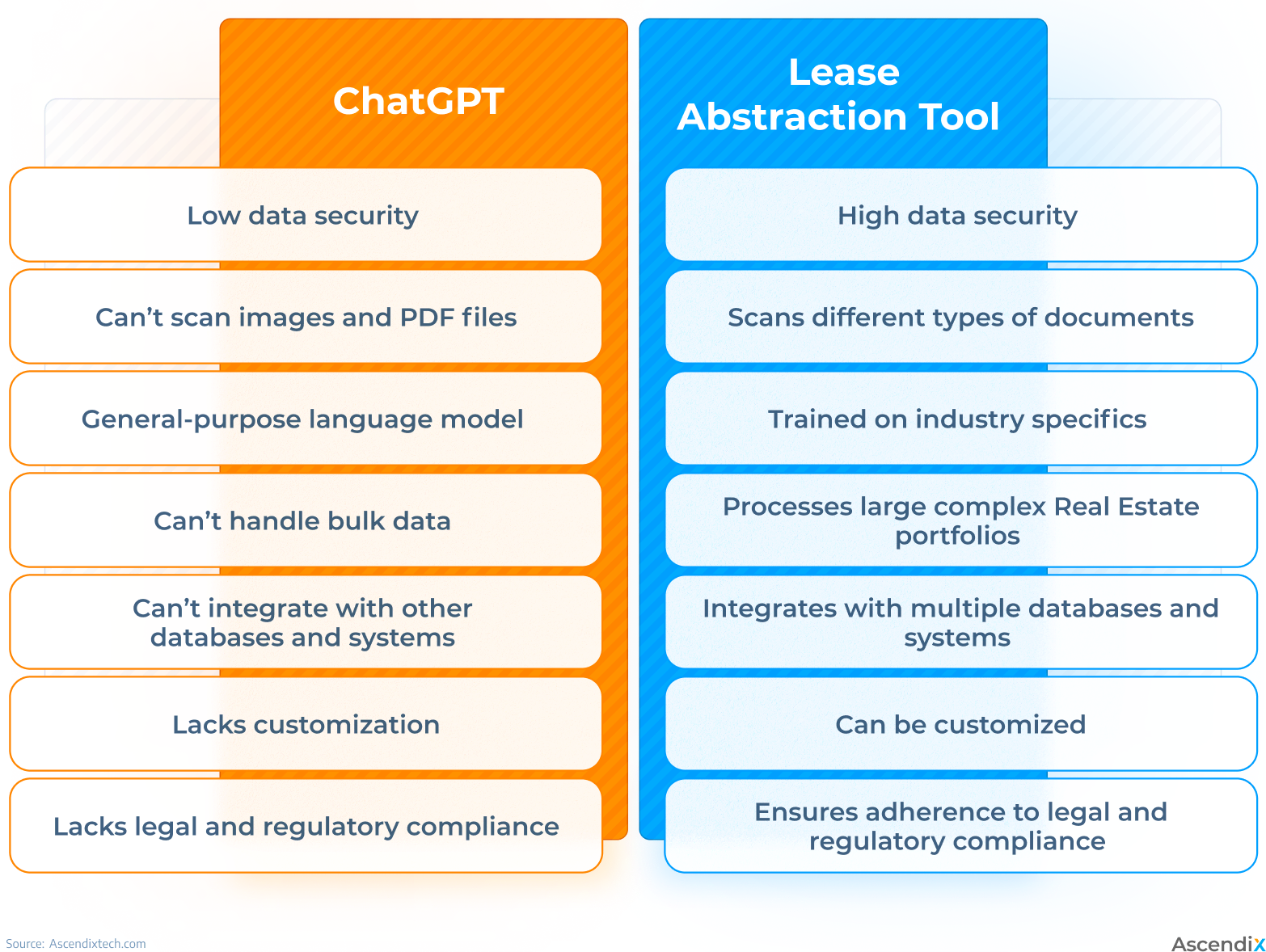
GPT vs Lease Abstraction Tool
ChatGPT has proved to be extremely helpful for real estate agents, and that’s totally fine if you are using it for lease and other document abstraction. However, you should be aware of several constraints:
You need someone who has been in real estate for years if not decades – someone who’ve learnt the ropes of real estate software development and knows how to ensure that your lease abstracting tool includes the desired functionality aligned with your business needs, offers top security to users, and streamlines the lease management process.
Why not focus on generic software development providers? Well, from what we’ve heard from our clients who have cooperated with generic software development companies, onboarding and discovery stages might take forever, and there might be zero post-development support if you somehow manage to get to the development stage at all.
We’ve been in the game for 2+ decades and helped companies like JLL, Colliers, and Hanna Commercial automate their real estate operations with proptech solutions. And unlike generic software development providers, we offer dedicated post-development support to ensure your software is scalable and efficient in the long run.
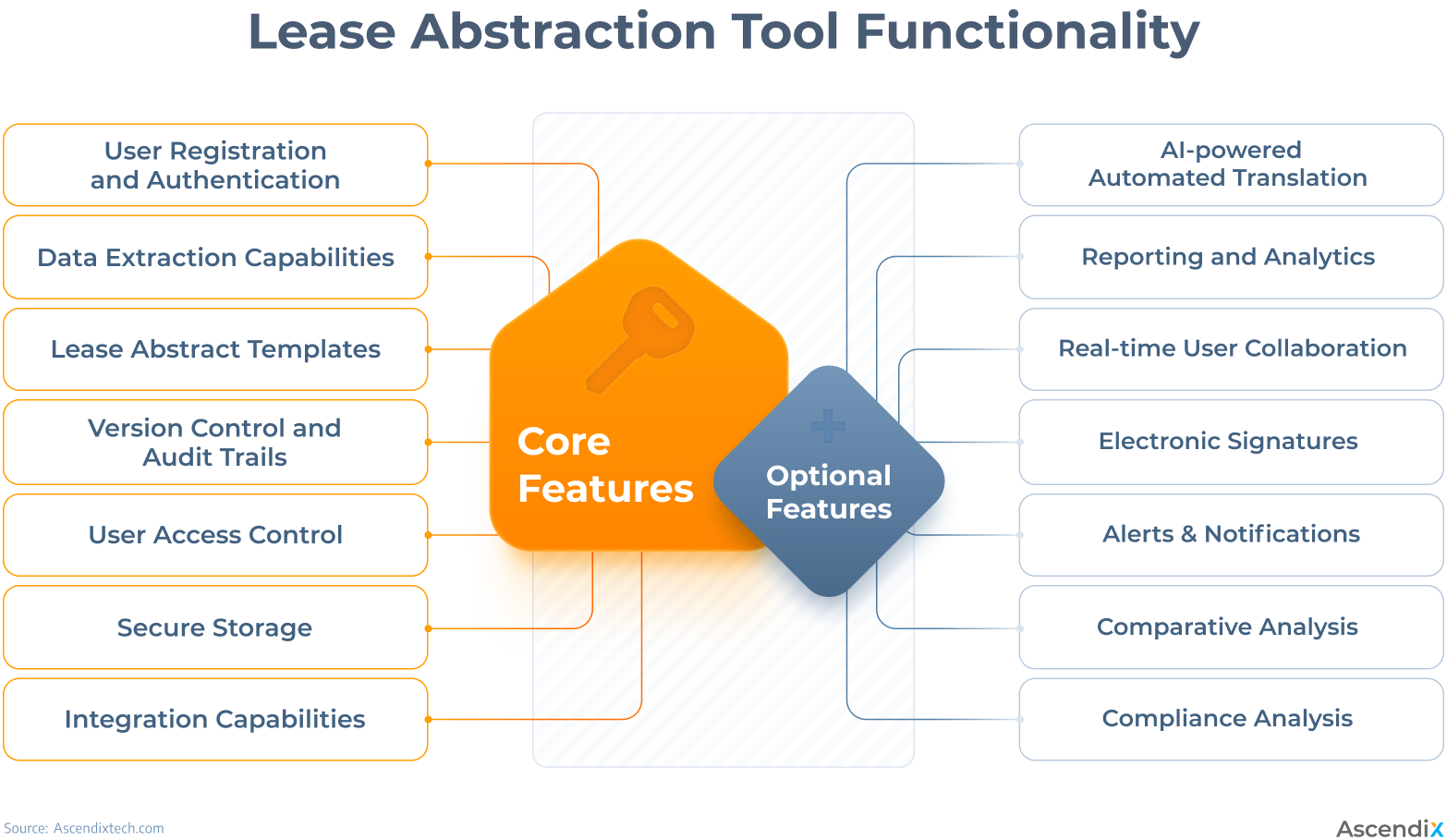
Lease Abstraction Tool Functionality
Let’s start with the core functionality which any lease abstracting tool must have.
User registration and authentication – Your software must include secure user authentication methods, such as multi-factor authentication, and ensure team members can easily onboard and set appropriate access levels;
Data extraction capabilities – obviously, the core functionality of your AI lease abstraction software, that’s why it should be powered by Optical Character Recognition (OCR) technology so your users can automatically extract key information from lease documents;
Lease abstract templates – will they be customizable, or will there be a separate library of pre-defined templates? If you’re building a tool for companies that deal with different types of documents daily, we advise you to ensure that users can customize data fields they want to extract. And don’t forget that the final lease abstract should be standardized and easy to navigate and search.
For example, we have implemented several customizable templates for summary results. According to their preferences, users can choose among a few options:
A short summary of the article in a one-paragraph format (commonly, such a summary is up to 1000 characters);
A table-format summary with Terms (“Base price,” “Commencement date,” etc.) and Values (“$350 000,” “14th day of November, 2024);
A combined summary where both text and a table are presented to offer a comprehensive view of the document;
And if users dislike all the options above, they can easily create a new template from scratch that will fully align with their specific requirements.
Version Control and Audit Trails – allow users to keep track of document versions and changes made over time, ensuring users are working with the most recent information. As you’ve seen from the screens above, we’ve built our tool with user-friendly design in mind, ChatGPT-like interface, where users can easily navigate between the document and summary sections;
User access control – most tools for automated lease abstraction offer role-based access control. For example, you might want to give some users read-only rights or assign reviewers/editors with the right to review lease abstracts generated by the AI tool and make manual adjustments or corrections;
Secure storage – users should be able to store their documents in the cloud and easily retrieve them from there, which, as you’ve already guessed, is impossible with ChatGPT, but can be done with lease abstraction AI tool;
Integration Capabilities – if you are working as part of a team with one pool of documentation or simply need to get automated summaries of documents already stored in your CRM / deal management system, you will appreciate the integration of your AI lease with your software ecosystem. If you do not need such integration now, make sure that you plan for API capabilities in your custom lease abstraction tool to ensure it can be linked with other systems in the future.
We can make your legacy & 3rd-party systems talk through well-thought-out APIs and integrations. Contact Ascendix today.
Once you’ve finished building the core lease automation functionality, it’s time to choose the optional functionality that will set your software apart from competitors in the market.
AI-powered automated translation – companies with global real estate operations might be looking for this capability so the leases they deal with can be accurately translated and understood across different languages;
Reporting and analytics – Tools may provide reporting features, offering insights into extracted data, lease trends, and other relevant analytics;
Real-time user collaboration – enable multiple team members to work on lease abstraction projects simultaneously;
Electronic signatures – users can sign documents online without a need to physically visit the agent’s office;
Alerts & notifications – once the software detects clauses, terms, and terminology that contradict legal norms, it will send an alert to the user. Also, some automated lease abstraction tools can remind users about ‘sign’ dates, hence prevent missed deadlines;
Comparative analysis – users can conduct comparison checks not only between two specific leases of their choice but also select a lease for comparison against all others in the system;
Compliance analysis – powered by natural language processing technology, this feature can ensure seamless compliance monitoring by automatically scanning lease documents for relevant clauses and regulatory requirements. And if the clause doesn’t comply with industry standards or legal regulations, the system will promptly flag it.
Once you’ve found a proptech development team, you can fully delegate the tool building task to them, but if you’re still interested in the front-end and backend development process in a nutshell and want to know how your AI lease abstraction tool will work from the system perspective, then keep reading.
In our lease abstraction AI development journey, we embraced the Minimum Viable Product approach at the initial stage. This meant creating a functional version of our product with just enough features to satisfy early users and gather crucial feedback for future enhancements. Listening to our users was fundamental, as their insights guided us in shaping the app according to their unique needs and preferences. That’s exactly what we’ll do for you too once you decide to build a proptech software with us.
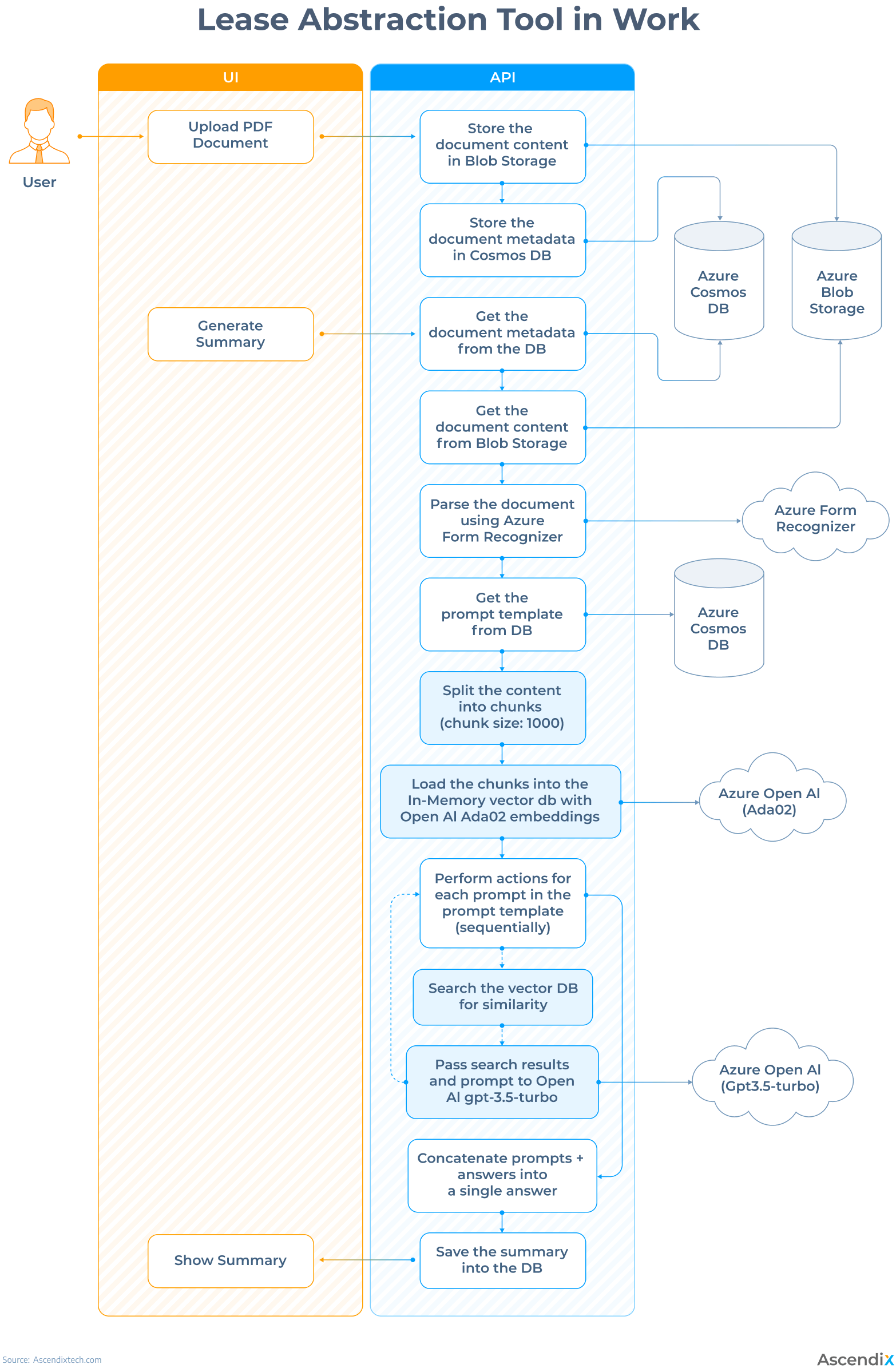
Lease Abstraction Tool in Work
First, our users must register (we’ve ensured the process is simple, safe, and requires basic user data), go through the authentication process and download their document from the local storage. Most of the current lease abstraction tools encourage users to upload their documents in PDF, and our tool does the same, but the functionality of your lease automation app might differ, allowing users to download files in other formats like doc.
With our tool, users can select pre-defined templates or create their own (FYI, some lease abstracting tools do the latter, while others don’t. Just think – What if the lease includes specific items that most leases don’t but which should be displayed in the summary?) and edit or manage the prompt template.
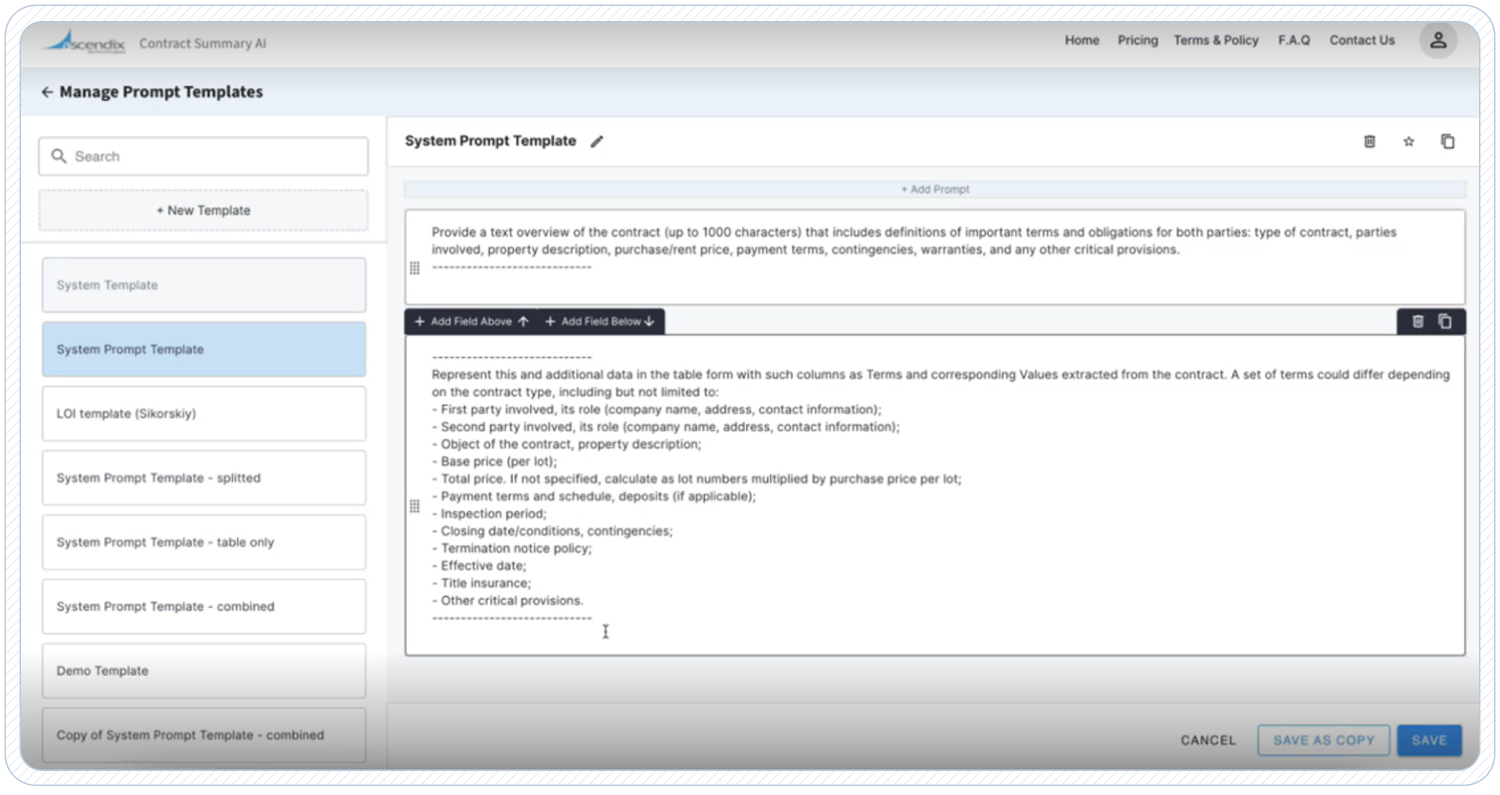
System Prompt Template
Further, users add the template to the system and apply it from there.

Manage Templates Interface
Oh, we almost forgot to mention that the app’s usability goes hand in hand with a sleek design.
During the development of our tool, we drew inspiration from the intuitive interface of ChatGPT. We envisioned a seamless experience for our users, allowing them to effortlessly switch between the Summary section, the lease reference, and their list of leases.
As you can see, the interface of our lease abstraction tool features a well-organized layout: the list of documents is neatly displayed in a separate column on the left, the summary of the document takes the center stage, and the open original lease is readily available for reference.
Once users upload their commercial lease in a PDF format, the lease content and metadata (without being split into chunks yet) are stored into two vector databases, Azure Blob Storage and Azure Cosmos DB respectively. Here, databases are vital elements, since they not only allow us to store user content and metadata separately, but generally ensure the document integrity and accessibility by acting as reliable and secure storage solutions.
Once the user presses the ‘Generate Summary’ button, the system retrieves both the content and metadata from the vector databases and turns the document into a machine-readable text with the help of Azure Form Recognizer.
Further, the prompt template is applied and with the LangChain library, the system splits the text received from Azure Form Recognizer into chunks and loads them into In-Memory vector database with the help of Azure OpenAI tool.
Yes, we’ve told you that using ChatGPT as a separate lease abstraction AI tool is inefficient, but what we haven’t told you is that ChatGPT is an essential integration to consider when building a lease abstraction AI tool. Let’s find out why.
Once users press the ‘Generate summary’ button, each chunk is processed separately and sequentially. The system looks for each template in the In-Memory database, conducts a similarity search for the prompt in order to reduce the amount of text to be analyzed and transfers the text and the prompt to ChatGPT 3.5 (this is the current version, but once the new version is launched, we can plug in the latter too if it can be supported by LangChain library).
Once ChatGPT answers the prompt questions, the system concatenates prompt answers into a single structured answer, and the format of the answer, which is basically the lease summary, will depend on the user’s choice. So, for this purpose, our tool provides users with format options like a short summary of the article in a one-paragraph format up to 1000 characters, a table-format summary, and a combination of the two.
The best part? We’ve ensured our users can build a perfect lease abstract with a little help from comparative analysis. Users can provide the system with what they consider to be the ‘ideal’ lease abstract, asking the system to evaluate the lease abstract by comparing it to the example.
In the end, the tool will score the abstract and identify any inconsistencies or missed data as a part of the feedback.
After processing the text chunks, our tool stores the lease abstract in the database, then returns and displays it to the user.
As developers, we prioritize the validity of user data. Therefore, users must manually validate the recognized handwritten blocks, accept them, and only after this process can they download their summary.
Currently, our users can download their lease abstracts in PDF only, but don’t forget that we can help you build an AI lease abstraction tool that allows your users to convert their commercial lease abstract into other formats like Excel spreadsheets.
Once we’ve built your lease abstraction tool, our professionals will rigorously assess every aspect of the software, verifying its ability to accurately extract and organize lease data in real-life scenarios.
Further, we’ll deploy your lease abstraction software on a server or company’s devices.
Post-deployment, our commitment to your satisfaction continues. We’ll provide dedicated support services to promptly address any inquiries or concerns that may arise during software usage. Our team will assist your staff during the onboarding process, ensuring they get the knowledge required to navigate the lease abstraction software effortlessly.
We speak real estate. We’ve been developing software products for real estate for 2 decades. Speak to Ascendix consultant.
Docsumo, a leading lease abstraction company, offers an all-in-one software that allows extraction from various document types, layouts, and tables, featuring pre-trained APIs and an intelligent OCR system. With a 99%+ accuracy rate, the tool extracts data from complex leases, eliminating manual errors and enabling fast decision-making for property managers, brokers, and law firms.
It categorizes data automatically, validates real-time data, integrates with other systems, and allows custom ML model training.

Docsumo’s Interface
Our wrap-up: We’ve checked the reviews and found out that 96% of Docsumo’s users are happy with the software. They claim that Docsumo is easy to navigate and companies can process up to 2000 leases in formats like Excel, images, and PDF per month.
On top of that, Docsumo is also an AI-powered lease accounting software – it allows users to calculate expenses and cash flows and decide on which property will bring the highest revenue in the long term.
Another lease abstraction company on our list, LeaseLens extracts essential lease data quickly and accurately, reducing abstraction time from hours to minutes. With over 200 industry standard fields, it customizes abstracts to your preferences, including critical dates, renewal options, and more.
The service is free to use for viewing abstracts, with a minimal $25 fee for exporting to Excel or Word templates. Plus, your data is secure – leases are deleted after abstraction, and privacy is a top priority.
Our wrap-up: We haven’t found enough reviews of LeaseLens online because unlike other AI lease abstraction companies on the list, LeaseLens is a startup and has only recently released its tool. If your business operations don’t require frequent lease abstracting and you’re in need of something simple and don’t want to install specific lease abstracting software, then definitely try LeaseLens.
This versatile lease abstraction software handles files from any format, even old scans. Whether in multiple jurisdictions or languages, Kira excels, adapting to Latin-script languages like French, Spanish, and German. Users can export metadata effortlessly to Word, Excel, or other systems, ensuring seamless data synchronization.
Kira’s robust search functionality streamlines review organization, allowing tailored searches for provisions and custom tags. Users can simplify comparisons with bulk redlining against a form, using the innovative “heat map” feature for swift analysis.
Our wrap-up: Users praise Kira’s ability to keep policy and law changes up to date, which is vital in terms of legal compliance. As for the drawbacks, some users note that Kira is a bit expensive compared to other automated lease abstraction providers and offers poor recognition of handwritten parts. Regardless of the complaints, we think that Kira is a top choice for global-scale real estate businesses in dire need of AI lease abstraction solutions adaptable to multiple formats and languages.
Imprima utilizes AI and machine learning to provide automated lease abstraction as a part of the entire lease management process. The tool offers 35 preset fields like “lease space,” “signing date,” and “price.” The values selected from this list are displayed beside the open document, allowing users to locate, edit, and add values.
Imprima enables document filtering by criteria such as price and end date, with export options to Excel. Additionally, it can paraphrase clauses and generate visually appealing client reports during lease reviews.
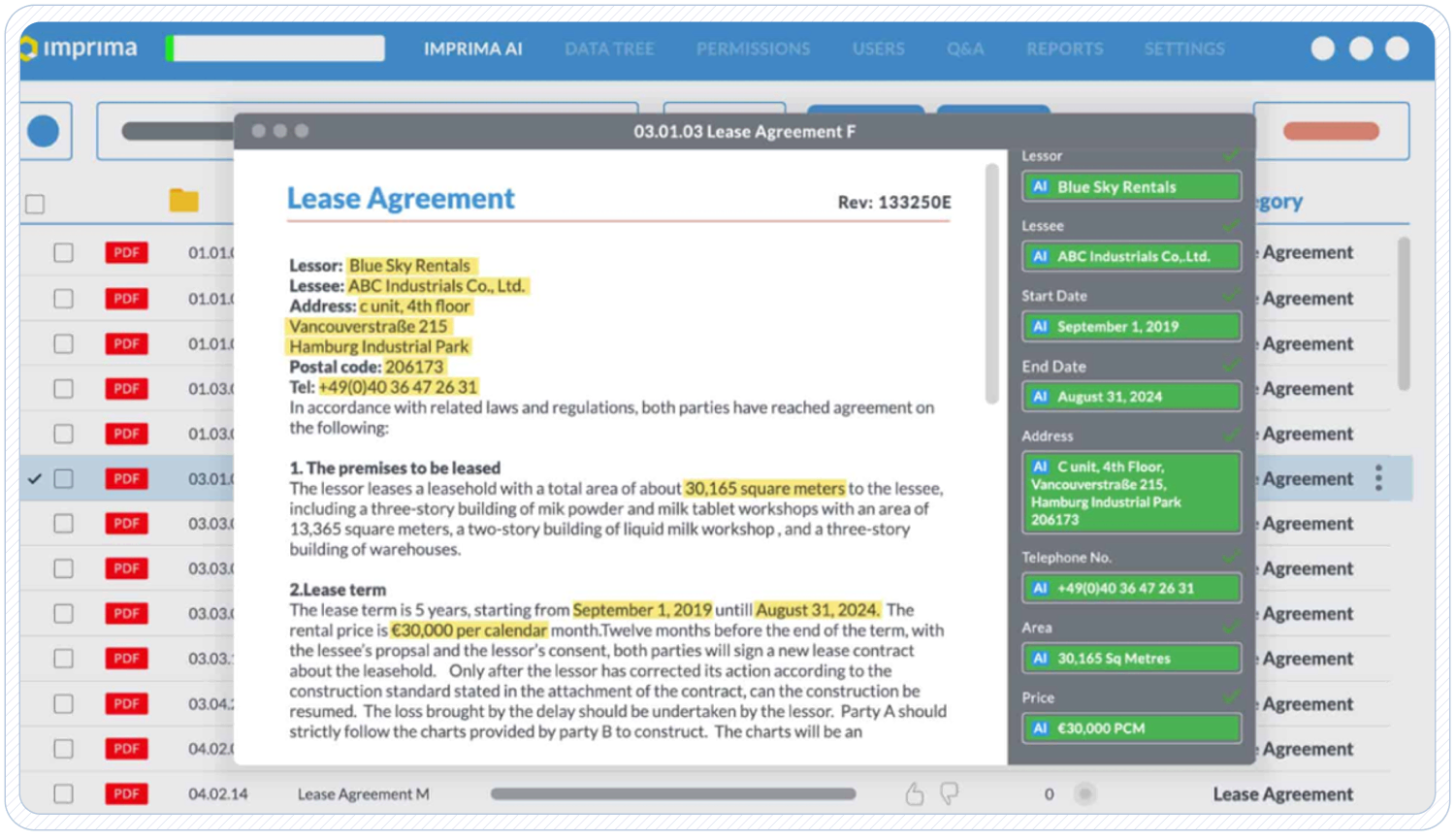
Imprima’s Interface
Our wrap-up: If your company deals with different types of leases on a daily basis (commercial lease agreements, software licenses, and mortgage contracts), Imprima is the right choice for you. As for the drawbacks, some users claim Imprima’s design to be non-user-friendly. So, yes, Imprima is for tech-savvy users. If you’re a first-time lease abstraction user, definitely switch to another software.
Summize speeds up the lease abstraction process by 85%. With its ‘Legal Frontdoor,’ users can engage with chatbots through Microsoft Teams and Slack, generating leases effortlessly from pre-approved templates. If legal advice is required, users can submit requests directly to the legal team. Summize enables task creation, commercial lease abstract generation, and easy sharing.
The tool conducts precise risk assessments, identifying areas for improvement, all presented in a familiar ‘Microsoft Office’ style, catering to lawyers’ preferred work environment.
Our wrap-up: Summize stands out as user-friendly software, particularly for non-tech users. So, if it’s your first time using an AI lease abstraction tool, opt for Summize, especially if your company is already using Microsoft Teams, Slack, Microsoft Office, or Salesforce, since Summize perfectly integrates with these systems.
At Ascendix, we assist established real estate businesses that aspire to empower their teams, including brokers, property managers, and legal specialists with AI capabilities in their daily operations.
Why Ascendix?
How can Ascendix help?
For real estate businesses who want to empower their teams (brokers, property managers, legal specialists) – we can build a new lease abstraction software from scratch, audit the existing one and upgrade it for optimal efficiency and scalability.
For startups with visionary ideas of building a lease abstract tool – a Minimum Viable Product (MVP) to attract investors. But it’s not only MVP we offer – we can build a brand new tool from scratch, empower it with APIs, and integrate it with legacy systems;
For investors looking for innovative startups – tech audit and consulting services to ensure your investment aligns with cutting-edge technology trends and promising ventures;
Contact us directly or book a free proptech call to learn how you can leverage our proptech development expertise.
AI lease abstraction is the process of extracting key information like parties’ responsibilities, lease terms, and financial obligations with the help of AI-powered lease abstraction tools from a commercial lease agreement and summarizing it into a concise document.
Lease abstraction tools currently on the market are Docsumo, LeaseLens, Kira Systems, Imprima, and Summize.
Tania is a fan of technologies and an expert in writing about them. In her content, she shares insights into new trends and proptech solutions in real estate that can help your business thrive while keeping your customers content (pun intended).
Get our fresh posts and news about Ascendix Tech right to your inbox.